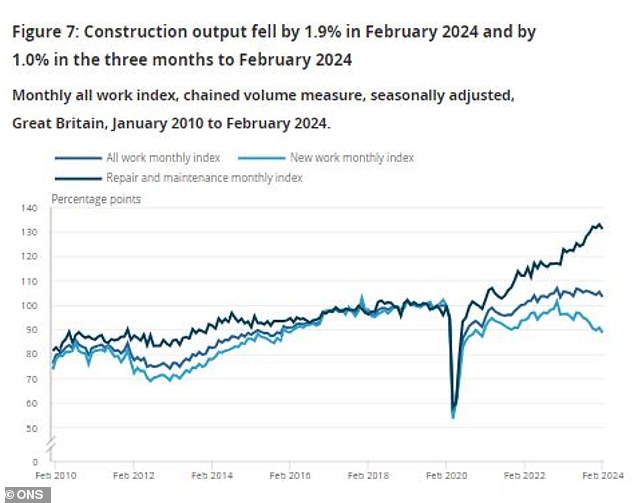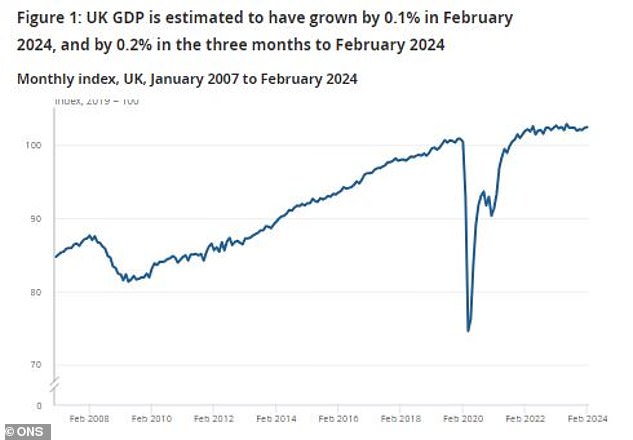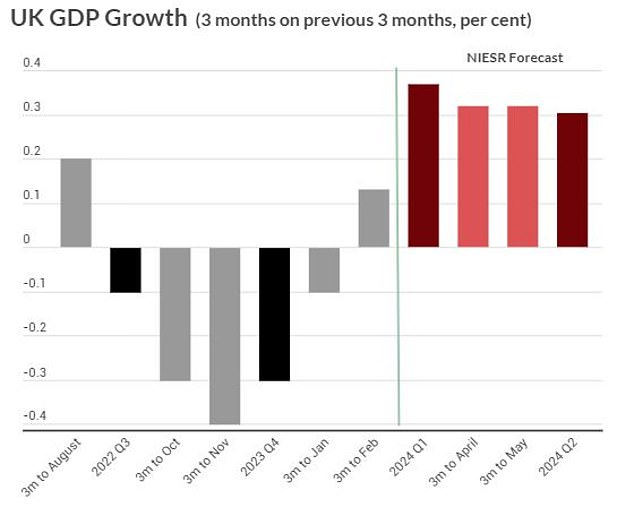The construction sector has been plagued by wet weather and high interest rates, holding back British economic growth
- Construction sector output fell 1.9% in February, according to the ONS
- The sector is hoping for interest rate cuts to stimulate demand
Construction output fell in February, weighing on overall economic growth, as wet weather and high interest rates undermined activity.
Construction sector output fell 1.9 percent in volume terms this month, leaving GDP growth at just 0.1 percent after all other sectors showed growth, Office for National Statistics figures showed on Friday.
The decline, which marks a contraction of 1 percent in the three months to February, was driven by a decline in activity in eight of nine subsectors – with private residential repair and maintenance the only area of growth, with an increase of 0.2 percent.
Project postponed: Production in the construction sector was depressed by the bad weather in February
Non-residential repair and maintenance and private commercial new construction were hit hardest, with a contraction of 2.5 and 4 percent respectively.
Experts have attributed the fall to particularly bad weather during the month, which held back construction projects after more than double the usual amount of rainfall in February, the Met Office said.
But the sector has also been hampered by the dominant influence of the British housing sector, which is building fewer homes this year.
The rise in the Bank of England’s base rate to its current level of 5.25 percent has pushed up mortgage rates, leading to a fall in new home purchases and a slowdown in house price growth.

Repair and maintenance work has led the construction sector since 2020, while production in the rest of the sector is weak
Shares in the homebuilding, building materials and trades sectors have fallen roughly 1 percent over the past month, led by a 5 percent decline for homebuilders, as investors worry about the possibility of interest rates staying higher for longer.
Nicholas Hyett, investment analyst at the Wealth Club, said the construction sector is “in the doldrums” and “a rate cut could be quite helpful.”
Broadly improved global economic output, combined with higher-than-expected US consumer price inflation this week, has pushed back forecasts for the BoE’s first rate cut and the scale at which key rates will fall this year.

UK GDP grew by 0.1% in February, while growth was upgraded to 0.3% in January
Current market prices now indicate that the first BoE cut will not occur until August, while the forecast size of cuts in 2024 is less than 50 basis points – meaning the current base rate of 5.25 percent will not fall below will decline 4.75 percent per year. end.
Sophie Lund-Yates, chief equity analyst at Hargreaves Lansdown, said: ‘The fall in construction activity also signals a wider malaise that Britain has yet to shake off.
“We’ve known for some time that big housebuilders are building fewer homes because people are waiting for finances to improve before making big financial decisions.
‘Overall, the pace of economic growth has slowed and a lot of extra coal is still needed to get Britain’s engines going.’

The National Institute of Economic and Social Research predicts UK GDP growth will improve and remain weak in the first half of 2024
